Marmaduke Langdale, 1st Baron Langdale of Holme
Marmaduke Langdale, 1st Baron Langdale (c. 1598 – 5 August 1661) was a leading Yorkshire Royalist during the Wars of the Three Kingdoms; although he was a talented commander of cavalry, his troops had a reputation for poor discipline.
Marmaduke Langdale, 1st Baron Langdale of Holme | |
|---|---|
| Baron Langdale of Holme | |
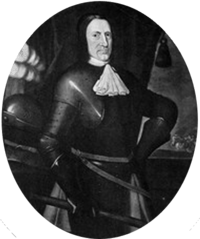 Marmaduke Langdale, 1st Baron Langdale of Holme | |
| Tenure | 1658–1661 |
| Successor | Marmaduke Langdale, 2nd Baron Langdale (son) |
| Born | 1598 (baptised) Beverley, Yorkshire |
| Died | 4 August 1661 (aged 63) Holme Hall, Yorkshire |
| Buried | All Saints church, Sancton |
| Nationality | English |
| Wars and battles | Thirty Years' War Wars of the Three Kingdoms 1642 – 1648 Marston Moor Naseby Rowton Heath Preston Siege of Candia 1652 |
| Offices | Sheriff of Yorkshire 1639 – 1640 Lord Lieutenant of the West Riding of Yorkshire 1660 – 1661 |
| Spouse(s) | Lenox Rodes (died 1639) |
| Issue
4 sons, 3 daughters; four survived to adulthood | |
| Parents | Peter Langdale (died 1617) Anne Wharton (1576–1646) |
After Royalist defeat in 1649, he followed the future Charles II into exile and converted to Catholicism in 1653. Created a baron in 1658, he was appointed Lord Lieutenant of the West Riding of Yorkshire after the Restoration of Charles in 1660 but his health and finances had been destroyed by the war and he died at his home of Holme Hall in August 1661.
Family
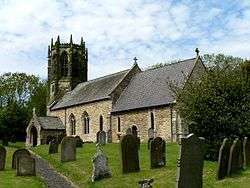
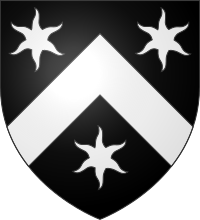
Marmaduke Langdale was born in 1598, only son of Peter Langdale (d.1617) and his wife Anne Wharton (1576–1646), who in 1606 purchased Pighill Hall, Molescroft, near Beverley in Yorkshire.[2] The name 'Langdale' allegedly came from the manor of Langdale in Yorkshire.[3]
In 1626 Langdale married Lenox Rodes (d.1639), daughter of Sir John Rodes (1562–1639) of Barlborough Hall, Derbyshire. Before she died in childbirth in 1639, they had seven children, four of whom survived to adulthood.[4]
- Marmaduke Langdale, 2nd Baron Langdale (1627–1703), eldest son and heir;
- Philip Langdale (died 1672);
- Lenox Langdale (died 1658), daughter;
- Mary Langdale (died 1678).[5]
Career
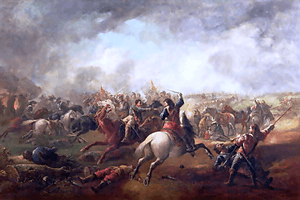
Langdale attended St John's College, Cambridge in 1612 and inherited his father's estates in 1617. His sister-in-law Katherine was the first wife of Sir John Hotham (1589–1645); in 1620, the two went to Europe and briefly fought for Elizabeth of Bohemia, sister of Charles I. Sir John was appointed Parliamentary Governor of Hull, Yorkshire in 1642 and executed for treason in 1645 along with his son John, whom Clarendon describes as a close friend of Langdale.
During the 1620s and 1630s, Langdale became an increasingly important local political figure; he was knighted in 1628 but he opposed the Forced Loan and payment of Ship money, both of which were attempts to rule without Parliament.[6] He was punished by being appointed Sheriff of Yorkshire in 1639, making him personally liable for any shortfalls in collecting the taxes. He eventually complied but was removed in July 1640 after organising a petition signed by leading members of the Yorkshire gentry listing their 'grievances.'[4]
He became a Royalist during the War of the Three Kingdoms in 1642, more from a sense of duty than conviction, and fought under the Marquess of Newcastle, Royalist commander in Northern England. After defeat at the Battle of Marston Moor in July 1644, he formed the surviving cavalry into the "Northern Horse". This regiment, which included the remnants of an estimated 30 others, was described as a "rabble of gentility" and quickly gained a reputation for poor discipline.[7]
In February 1645, Langdale relieved Pontefract Castle, but the behaviour of his troops damaged the Royalist cause and without infantry support he was forced to retire, leaving the castle to be besieged once more. In June the Northern Horse formed the Royalist left wing at the Battle of Naseby; they initially held their ground against Cromwell's more numerous and better disciplined troopers before being outflanked and driven from the field.[8]
The survivors of Naseby, which included the Northern Horse, withdrew to Raglan Castle in South Wales, but on 10 July the last significant Royalist field army in England was destroyed at the Battle of Langport. Langdale and other Yorkshire Royalists wanted to go north to link up with Montrose, who won a series of victories in Scotland from 1644 to 1645. Charles agreed but only after lifting the Siege of Chester, his last major port in the West and vital for communication with supporters in Ireland. On 24 September the Royalists were defeated at the Battle of Rowton Heath.[9]
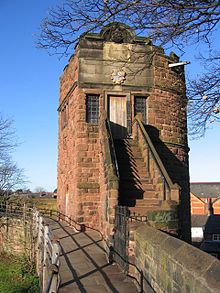
News came of Montrose's defeat at the Battle of Philiphaugh on 13 September. Langdale and Lord Digby escaped from Chester with about 2,400 cavalry, but on 15 October a Parliamentarian army intercepted and dispersed their forces at Sherburn-in-Elmet. Digby and Langdale escaped to France and the First Civil War came to an end in June 1646.
When the Second Civil War began in 1648, Langdale returned from exile to lead the Royalists in Cumberland and seized the border town of Berwick-upon-Tweed to enable his Scottish Engager allies to invade England. Major-General John Lambert, Parliamentary commander in the North, avoided battle, but in August was joined by Cromwell and Fairfax who had defeated Royalist risings in Wales and Southern England. Langdale met up with the Duke of Hamilton's Scottish Engager army but they were decisively defeated by Cromwell at the Battle of Preston, over a period of three days between 17 and 19 August.[10]
Along with much of the cavalry, Langdale and Hamilton evaded capture at Preston but were taken shortly afterwards and imprisoned in Nottingham Castle. The Second Civil War convinced Parliamentarians, including Cromwell, that peace could only be assured by the death of prominent Royalists; Hamilton was executed, as was Charles himself in January 1649. As one of seven Royalists excluded by name from pardon, Langdale avoided a similar fate by escaping dressed as a milkmaid and made his way to France once again.[11]
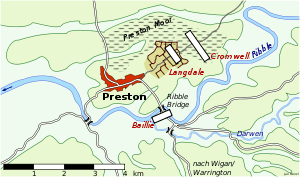
Under the 1650 Treaty of Breda, the Scots Covenanters agreed to restore Charles II to the English and Scots thrones but insisted on the exclusion of many of those who followed him into exile.[12] As a result, Langdale did not participate in the Third English Civil War, also known as the 1650–1651 Anglo-Scots War. He converted to Catholicism in 1652 and joined the army of the Republic of Venice but was forced to retire due to poor health. Unlike most Catholic members of the court-in-exile, he advocated a Spanish rather than French alliance to regain Charles' throne. In 1655 his poverty and lack of influence led him to take refuge at the English Benedictine community of Lamspringe Abbey in Westphalia.
In 1658, Charles created him Baron Langdale; after the Restoration in 1660, he was appointed Lord Lieutenant of the West Riding of Yorkshire but claimed he was too poor to attend Charles' coronation.[13] he died in August 1661 at Holme and was buried in All Saints Church, Sancton, where his memorial survives, along with others belonging to the Langdale family.[14]
References
- Robson, Thomas, The British Herald
- Baggs et al. 1989, pp. 281–291.
- Burke 1831.
- Hopper 2004, pp. Online.
- "Marmaduke Langdale". Cracrofts Peerage Online. Retrieved 23 March 2019.
- Cust 1985, p. 211.
- Barratt, John. "A Rabble of Gentility"? – The Northern Horse, 1644–45". Helion & Co; Military History. Retrieved 22 March 2019.
- Young & Holmes 2000, p. 234.
- "The Siege of Chester and Battle of Rowton Heath". BCW Project. Retrieved 22 March 2019.
- "The Second Civil War; Overview". BCW Project. Retrieved 22 March 2019.
- Royle 2004, p. 470.
- Royle 2004, pp. 562–563.
- Royle 2004, p. 772.
- Sheehan & Whellan 1867, p. 392.
Sources
- Baggs, A. P.; Brown, I. M.; Forster, G. C. F.; Hall, I.; Horrox, R. E. (1989). Allison, K. J. (ed.). 'Outlying townships: Molescroft', in A History of the County of York East Riding: Volume 6, the Borough and Liberties of Beverley,. Victoria County History. ISBN 978-0197227763.CS1 maint: ref=harv (link)
- Burke, John (1831). A General and Heraldic Dictionary of the Peerages of England, Ireland, and Scotland, Extinct, Dormant, and in Abeyance. England (2017 ed.). Andesite Press. ISBN 978-1375518789.CS1 maint: ref=harv (link)
- Cust, Richard (1985). "Charles I, the Privy Council, and the Forced Loan". Journal of British Studies. 24 (2).CS1 maint: ref=harv (link)
- Hopper, Andrew (2004). Langdale, Marmaduke, first Baron Langdale. Oxford DNB.CS1 maint: ref=harv (link)
- Royle, Trevor (2004). The Wars of the Three Kingdoms 1638–1660. Little, Brown. ISBN 978-0-316-86125-0.CS1 maint: ref=harv (link)
- Sheehan, J. J.; Whellan, T. (1867). History and Topography of the City of York and the East Riding of Yorkshire, Volume II. John Green, Beverley.CS1 maint: ref=harv (link)
- Young, Peter; Holmes, Richard (2000). The English Civil War:A Military History of the Three Civil Wars, 1642–1651. Wordsworth Editions. ISBN 978-1-84022-222-7.CS1 maint: ref=harv (link)
External links
- Barratt, John. "A Rabble of Gentility"? – The Northern Horse, 1644-45". Helion & Co; Military History.
- "The Second Civil War; Overview". BCW Project. Retrieved 22 March 2019.
- "The Siege of Chester and Battle of Rowton Heath". BCW Project. Retrieved 22 March 2019.
- "Marmaduke Langdale". Cracrofts Peerage Online. Retrieved 23 March 2019.
| Political offices | ||
|---|---|---|
| Preceded by Sir William Robinson |
High Sheriff of Yorkshire 1639–1640 |
Succeeded by Sir John Buck |
| New creation | Lord Lieutenant of the West Riding of Yorkshire 1660–1661 |
Succeeded by 2nd Duke of Buckingham |
| Peerage of England | ||
| New creation | Baron Langdale 1658–1661 |
Succeeded by Marmaduke Langdale, 2nd Baron Langdale |